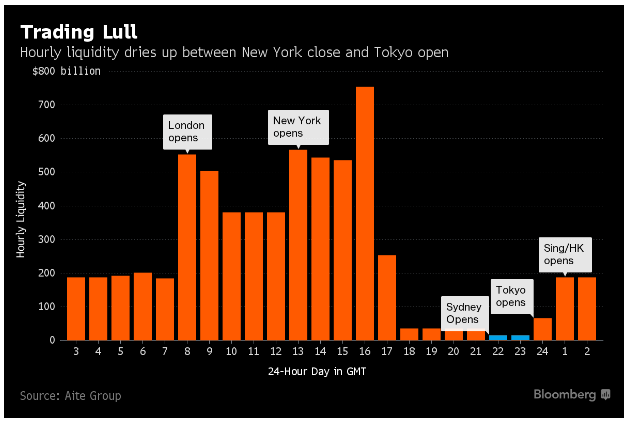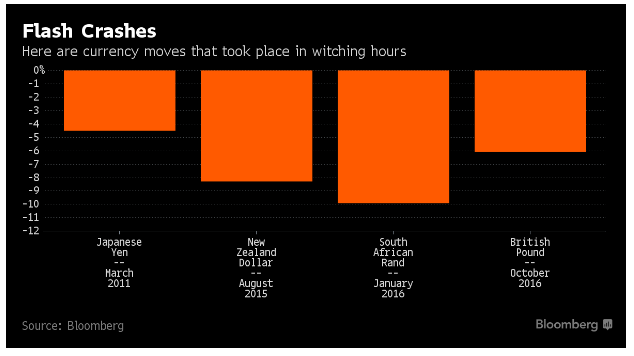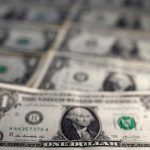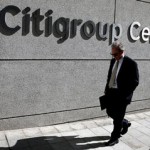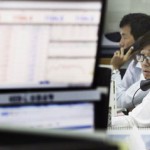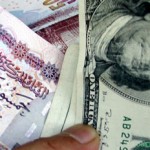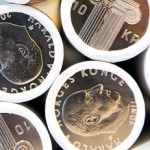This is the darkest hour in global currency market that haunts currency traders
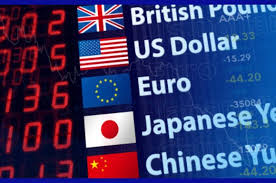
In the global currency market, the darkest hour comes just as dawn is breaking in Asia and traders in Sydney are sipping their first flat white.
Between the New York close and the start of trading in Tokyo, foreign-exchange volumes dwindle to just 2 per cent of peak turnover, according to Aite Group, a consultant in Boston. As a result, any transaction in that two-hour window will hit the market disproportionately hard.
The plunge in Britain’s pound earlier this month shows what’s at stake. About 7am Singapore time (9am AEST) – while London dealers were sleeping and those in New York were finishing up their day – sterling slumped more than 6 per cent in just two minutes, reaching a 31-year low.
After that, traders are more wary of leaving automatic sell orders known as stop-losses in place at times when fewer people are working and bouts of extreme volatility are more common.
“It’s always been a danger zone with respect to stop-losses; certainly after this, people will think about it even more,” said Anthony Hall, head of foreign exchange, rates and credit in Asia-Pacific at UBS, the world’s third-biggest currency trader. “If you think about how the structure of the market’s changing, how you would have executed orders and left stop-losses in the past is no longer applicable today.”
The severity of the pound’s drop suggests that algorithms triggered an avalanche of automatic sell orders, adding to the pressure on the world’s fourth-most traded currency, according to UBS and Singapore-based DBS Group. UBS processed its highest volume of trades in a minute as sterling plunged, Hall said.
‘Unheard of’
“Movements like this recent pound crash will likely happen again at some point in time,” said Peter Soh, head of foreign exchange in Singapore at DBS. “Looking back, say five years ago, moves of this intensity were unheard of.”
What’s changed is that post-2008 crisis regulations have caused global investment banks to pull back from dealing, while electronic traders take on a growing share of the $US5.1 trillion-per-day market in their place. Lenders have backed off because, under the Volcker Rule, they are restricted from trading for profit with their own money. Computer traders have stepped in, more than tripling currency volumes in the last three years, according to Aite Group.
According to Javier Paz, a senior analyst at Aite Group.in Salt Lake City, Utah, liquidity across all currencies and foreign-exchange products hits a low of $US16 billion from 8 am to 9 am Sydney time, which is two hours ahead of Tokyo. So that’s before desks in Singapore, Hong Kong and Tokyo are fully staffed. Liquidity climbs steadily, reaching about $US550 billion at the London open. That compares with a peak of about $US750 billion at the so-called 4pm fix in London, when markets in the US also are open, Paz said.
‘Twilight Zone’
“The decline in market-making at the major foreign-exchange players means the distribution of liquidity has become more uneven,” said Christopher Brandon, co-founder of Singapore-based hedge fund Rhicon Currency Management, which manages almost $US600 million. “You get pockets of liquidity, and then pockets of illiquidity. These things are happening a bit more than previously.”
The pound’s flash crash took place when many banks in Asia had taken over currency trading while most stock markets in the region had yet to open – during a period that Jesper Bargmann, Nordea Bank’s head of trading for Asia, called the “Twilight Zone”. While such price swings are a concern for the bank’s clients who need to execute a trade when liquidity is low, they may also offer traders and investors opportunities to profit from pricing discrepancies “as markets settle back to fair value at a later time,” he said.
“It may happen more and more now that we have fewer speculative players as buffers in the market,” said Singapore-based Bargmann.
Hedge funds and proprietary traders reduced their share of global currency trading to 8 per cent in April, from 11 per cent three years earlier, according to the Bank for International Settlements. Daily trading in global currencies has shrunk almost 6 per cent since 2013, BIS data shows.
For some currencies, sudden movements have come at other times of the day, when commercial flows form a smaller part of their total turnover, Bargmann said. New Zealand’s dollar had its own flash crash in August last year at 1am local time, and the yen soared more than 4 per cent in less than half an hour as markets closed in New York in March 2011. It took just 15 minutes for South Africa’s rand to plummet by the most since 2008 as the Australian market was opening on a Monday in January.
“The risk to such sharp price dislocations is inevitably much larger outside of the main trading hours for the local currency,” said Sean Keane, an Auckland-based analyst at Triple T Consulting and the former head of Asia-Pacific rates trading at Credit Suisse Group AG.
The market is most liquid when trading hours in the UK and US – the world’s predominant foreign-exchange centres – overlap and asset managers and hedge funds are more active. As much as 90 per cent of currency transactions in the US session take place when markets in Europe are open, said Paz at Aite Group. After that, liquidity gradually drops for the rest of the US trading day and evaporates by the time traders in Sydney start their day.
“This witching hour remains a vulnerability for the 24-hour nature of [foreign exchange] markets,” Paz said. “At an illiquid period, it doesn’t take much for someone’s order to sweep the book of sterling liquidity available.”
Source: The Sydney Morning Herald – Curse of the witching hour haunts currency traders









